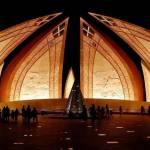Pakistan which came into being in 1947 was once a part of Hindustan subcontinent; therefore it holds many mind-blowing things to see, both natural and man-made places which were once in the territory of British Raj. No doubt it is very difficult to narrow the list of breathtaking and incredible historical sites in Pakistan, but here we are ranking Top 5 Must See Historical Places Of Pakistan on the basis of popularity and tempting features to attract the visitors.
So let’s begin the journey of marvellous places of Pakistan to witness historical wonders which not only emphasizes the human history but also its civilization.
5- Rawat Fort, Rawat
Proudly standing in the Pothohar plateau of Pakistan, near the city of Rawalpindi in the province of Punjab, the Rawat Fort was built to defend the Pothohar plateau from the forces of the Pashtun king Sher Shah Suri in the early 16th century. The visitors have asked government to look after the fort as a lot of history is buried in this small fort and it’s not being maintained from a long time. Worth visiting to praise the architecture and history of Islam among the forgotten relics spread across the dry and arid land of Potohar Plateau.
Built by the local tribe the Gakhars during their rule, Rawat Fort is an impressive example of the era’s architecture. Because of its prominent position along old trade routes, the fort served as a bastion of regional power and a formidable defense against invasions.
In spite of years of degradation, Rawat Fort’s formidable walls, bastions, and entrances remain unaltered, serving as a monument to Pakistan’s history. Imagine what life was like for the people who lived in the fort’s many rooms, corridors, and courtyards when you visit this historic site.
Although Rawat Fort isn’t as famous as other Pakistani landmarks, its role in protecting the region’s history and culture is crucial. Travelers and history buffs interested in Pakistan’s past will find Rawat Fort to be an intriguing window into the country’s illustrious architectural and historical legacy.
4- Badshahi Mosque, Lahore
The superflous masterpeice of Mughal era, the Badshahi Mosque is lying in Lahore, capital of the Pakistani province of Punjab. It’s the second largest mosque in Pakistan which was commissioned by the sixth Mughal Emperor Aurangzeb in 1671 and completed in 1673. No doubt, the Badshahi Mosque tempts foreign and local tourists for holding the Islamic museum and Quran written with Gold wire. Anyone having desire to go back to Mughal era must walk through the astonishing huge courtyard and Islamic architecture.
3- Chaukhandi tombs, Karachi
At 29 km east of Karachi, Chaukhandi tombs, the elaborate sandstone carvings discovered by farman Hussain Jokhio. It is believed that the tombs were built during Mughal rule sometime in the 15th and 18th centuries when Islam became dominant. And these tombs are resting place of Jokhio tribe and mainly Baloch tribes. Some might consider it an ordinary graveyard, but it is highly recommended to cherish remarkable craft done on stones as each carving on grave symbolizes story about person’s gender, social status, age etc.
2- Pakistan Monument, Islamabad
Monument in Shakar Parian National Park, Pakistan, is a man-made historical place of Pakistan which was opened in 2007 to symbolize national unity. The place is not too crowded and highly safe for families. Pakistan monument is all about glance of statues of national heroes and informative and knowledgeable Museum which reflects history, culture and heritage of Pakistan.
1-Mohenjo-daro
The best place for history geeks is Mohenjo-daro. Even the name suggests that the place is holding incredible ancient stuff in itself. One of the largest settlements of the ancient Indus Valley civilization, this archaeological site ‘Mohenjo-daro’ is perched out in the province of Sindh, Pakistan. The place excavated in 1980, is mystery in itself and it bless you a thrill to travel back more than 4500yrs in one of mankind’s earliest civilizations. Hindus consider this place as a sacred site as they believe that this was the place where Sanatan Hindu Religion was born. The place may surprise for being damn ancient as the sewer systems, pools, wells and belongings does not reflect the possessions of ancient people.








